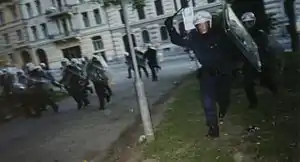Baton charge
A baton charge, also known as a lathi charge, is a coordinated tactic for dispersing crowds of people, usually used by police or military during public order places.

The tactic involves police officers charging at a crowd of people with batons and in some cases, riot shields. They run at the crowd hitting people with their batons, and in some situations use riot shields to push them away. Baton charging is designed to cause pain or fear of pain, in the hope that they would be compelled to move away from the scene, dispersing the public who are crowded.
South Asia
In South Asia, notably India, Bangladesh, Pakistan, and Sri Lanka, a baton would often be referred to as a lathi. Some Indian police forces use lathis around 1.5 m (5 ft) long, but in other places lathis are shorter. The term lathi charge is used on the Indian media more commonly than "baton charge".[1] In Bangladesh, the baton user is called a lathiyal and lathials who have a long history policing. The lathi khela is a traditional Bengali martial art.[2]
British Rule
During British rule in India, lathi charges were a common method used by the police to disperse protesting Indian independence activists. In 1928, Lala Lajpat Rai was heavily injured during a lathi charge, while protesting against government policies. Rai subsequently addressed the crowd and said, "I declare that the blows struck at me today will be the last nails in the coffin of British rule in India". Rai died of his injuries on 17 November 1928.
Post-1947
Lathi charges are used to disperse protesters in South Asia by the Indian, Pakistani and Bangladeshi police.
Hong Kong
In the 2019–20 Hong Kong protests, the police special unit Special Tactical Squad used the same tactics and was criticized that they used excessive force against the crowd and the journalists in order to break up the protest.[3]
References
- Police lathi charge protesters Times of India-Retrieved 29 July 2010
- Bipasha Raha; Subhayu Chattopadhyay (22 December 2017). Mapping the Path to Maturity: A Connected History of Bengal and the North-East. Taylor & Francis. pp. 102–. ISBN 978-1-351-03412-8.
- Hong Kong police attack journalists with batons, tear gas amid protests Committee to Protect Journalists-Retrieved 15 June 2019